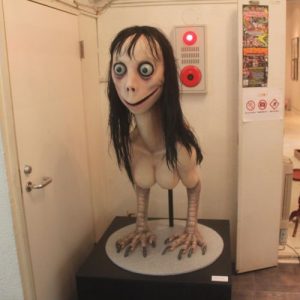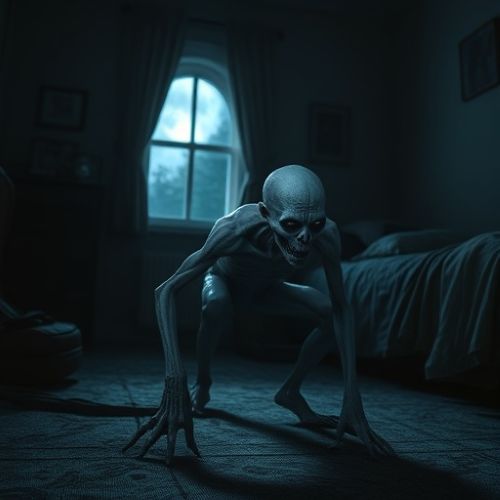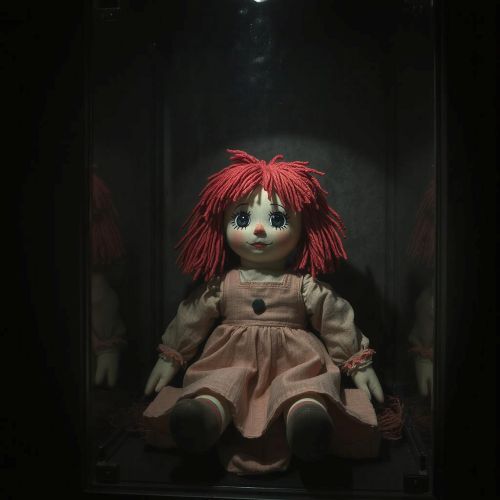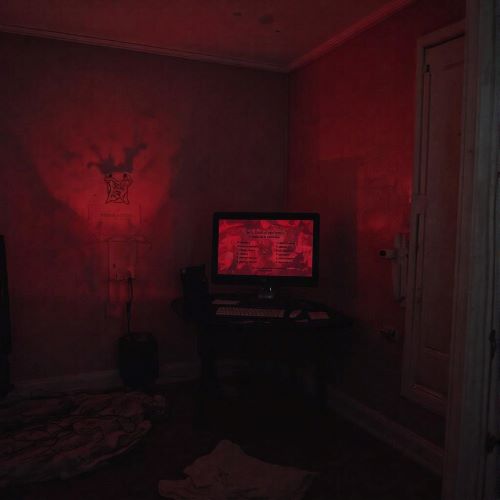Momo : The Internet Horror Icon Behind the Viral Panic
| Description | |
|---|---|
| Origin | Internet |
| Classification | Digital |
| Demeanour | Evil |
| Habitat | Online |
| Status | Proved Hoax |

Momo
Introduction
The story of Momo is one of the clearest examples of how modern folklore forms and spreads at unprecedented speed through digital networks. Although Momo became widely known in the United States around 2018, its origin lay not in traditional mythology but in internet virality. The unsettling figure, initially linked to the so-called “Momo Challenge,” was believed to target children online, urging them to engage in harmful tasks. Investigations later revealed that the panic stemmed mostly from hoaxes and exaggerated claims, yet the fear it produced was real and widespread. What makes Momo particularly significant is not only the horror associated with its image but the way it exposed parental anxieties, online vulnerabilities, and the uncontrollable nature of digital-age storytelling. Interestingly, the same name also refers to an entirely separate American cryptid known as “Momo the Missouri Monster,” a regional legend dating back to the early 1970s, adding another layer of confusion and cultural fascination around the name.
Physical Attributes
Momo’s infamous design originated from a sculpture titled Mother Bird by Japanese artist Keisuke Aiso. The piece featured an unnervingly distorted female face with bulging, protruding eyes, a stretched and unnatural smile, and long, stringy black hair that framed its hollow expression. The body of the sculpture was mounted on bird-like legs, contributing to its eerie hybrid appearance. This haunting design, though created as a work of art and later destroyed by the artist, became the visual foundation of the Momo urban legend once it began circulating online. The unsettling aesthetic—especially the wide-eyed stare—was a key reason it captured global attention so quickly and became associated with online fearmongering.
At the same time, Missouri folklore describes a completely different entity also known as Momo. This regional cryptid, first reported in the early 1970s, was said to be a tall, dark, ape-like creature covered in thick hair, with glowing orange eyes and a powerful, foul odor. Standing around seven feet tall with a rounded head almost entirely concealed by shaggy hair, this version of Momo bears no connection to the internet legend beyond the shared name. Yet the dual identity has occasionally caused confusion and added to the mythos surrounding the term “Momo.”
First Sighting/Reporting
The first major wave of Momo reports appeared in 2018, when stories circulated that children were encountering a mysterious WhatsApp account using the Momo image. Rumors claimed that this account issued dangerous tasks that escalated to self-harm, supposedly reinforced by threatening messages. These claims originated largely from media reports in Latin America before spreading to other regions, including the United States, where schools and law enforcement agencies issued warnings despite the lack of verified incidents. As fact-checking groups later confirmed, evidence of the challenge’s existence was minimal, and the panic had been amplified by viral news and parental fear rather than real cases.
Long before the internet hoax, Momo the Missouri Monster had its own first reported sighting in July 1972 near Louisiana, Missouri. Two children claimed they saw a large, dark creature at the edge of the woods holding a dead dog. Their older sister reported seeing the same figure shortly afterward. This triggered a series of additional local sightings throughout that summer, leading to a search party organized by concerned residents. No physical evidence was found, but the incident became one of Missouri’s most notable cryptid stories.
Other Names
The internet legend is most commonly known simply as Momo, though several alternate names emerged as the panic deepened. “Momo Challenge” became the dominant term used by the media, referring to the alleged sequence of harmful tasks. “Mother Bird” refers specifically to Aiso’s original sculpture that unintentionally became the face of the legend. Some online communities referred to the entity as the “WhatsApp Demon,” capturing the fear that it could unexpectedly appear in children’s messages.
The Missouri creature, meanwhile, is widely known as Momo the Missouri Monster, emphasizing its local roots and distinguishing it from Bigfoot-like creatures in other parts of the United States.
Modus Operandi
The supposed modus operandi of the Momo internet figure involved infiltrating social platforms—particularly WhatsApp and YouTube—where it allegedly contacted young users. These messages were said to contain unsettling images alongside instructions to carry out harmful tasks, reinforced by threats of violence if the user did not comply. While this framework of coercion was widely publicized, later investigations concluded that most of these claims lacked credible evidence. The panic, while powerful, was largely the result of viral scare tactics, media sensationalism, and exaggerated reporting rather than a coordinated effort or organized digital attack.
The Missouri cryptid, by contrast, is described as a shy yet ominous presence haunting forest edges, rural roads, and residential areas. Witnesses described the creature watching from the tree line, leaving behind three-toed tracks, and emitting a foul odor that seemed to precede its appearance. Encounters were generally brief, with the creature quickly retreating into the woods.
Pop Culture References
Despite being debunked, the Momo internet legend continues to influence online culture. It inspired horror artwork, creepypasta stories, short films, and countless reaction videos. News organizations used it as a case study in the dangers of misinformation and moral panic, ensuring the story stayed in public consciousness even after its credibility faded. Momo has also been compared to other digital-age myths like Slender Man, reinforcing its place in contemporary internet folklore.
The Missouri Monster also found its place in popular media. The 2019 docudrama Momo: The Missouri Monster blended documentary interviews with B-movie reenactments to explore the story. The creature appears in cryptozoological discussions, podcasts, and regional folklore books, where it is often highlighted as one of America’s lesser-known but intriguing cryptids.
Current Status
Today, the Momo Challenge is accepted as a hoax, with no confirmed cases linking it to actual harm. Keisuke Aiso, distressed by the misuse of his sculpture, destroyed the original artwork in an attempt to put the legend to rest. Nonetheless, Momo remains a powerful example of how digital myths can shape real-world fear and parental concern.
The Missouri cryptid version of Momo continues to exist primarily as a regional curiosity, occasionally resurfacing through documentaries, local stories, and cryptid-focused discussions. While modern sightings are rare, the legend still contributes to the cultural identity of rural Missouri and serves as a reminder of how local folklore can persist across generations.
Source
American Hauntings Ink. (n.d.). Momo the Monster. American Hauntings. https://www.americanhauntingsink.com/momo
Columbia Daily Tribune. (2015, January 26). Hungry pup leads to legend of “MoMo.” Columbia Daily Tribune. https://www.columbiatribune.com/story/lifestyle/around-town/2015/01/26/hungry-pup-leads-to-legend/21768424007/
Legends of America. (2025, November 19). Momo – The Missouri Monster. Legends of America. https://www.legendsofamerica.com/momo-monster/
Joint National Park Association. (2023, October 30). Momo the Missouri Monster. JNPA Blog. https://jnpa.blog/tag/momo-the-missouri-monster/
Robert, M. (2019, September 18). Robert’s review: Momo: The Missouri Monster (2019). The Scariest Things. https://scariesthings.com/2019/09/18/roberts-review-momo-the-missouri-monster-2019/
Thompson, A. (2024, July 26). The Missouri Monster “Momo” is the cryptid time forgot. VICE. https://www.vice.com/en/article/the-missouri-monster-momo-is-the-cryptid-time-forgot/
Wikipedia contributors. (n.d.). Momo the Monster. In Wikipedia. Retrieved November 26, 2025, from https://en.wikipedia.org/wiki/Momo_the_Monster
Balanzategui, J. (2020). The Momo Challenge as Urban Legend: Child and Adult Digital Cultures and the Global Mediated Unconscious. Cambridge University Press. Retrieved from https://www.cambridge.org/core/books/monstrous-beings-and-media-cultures/momo-challenge-as-urban-legend-child-and-adult-digital-cultures-and-the-global-mediated-unconscious/8D5C8EED5C28B7A0A181A58523B30230
BBC News. (2019, February 28). Momo challenge: The hoax and the hysteria explained. Retrieved from https://www.bbc.com/news/technology-47393510
The Guardian. (2019, March 1). Momo challenge: How a creepy internet hoax spread fear worldwide. Retrieved from https://www.theguardian.com/technology/2019/mar/01/momo-challenge-hoax-explained
Rolling Stone. (2019, March 4). The truth about the Momo challenge. Retrieved from https://www.rollingstone.com/culture/culture-news/momo-challenge-hoax-explained-799598/
USA Today. (2019, March 1). Momo challenge hoax: What parents need to know. Retrieved from https://www.usatoday.com/story/news/nation/2019/03/01/momo-challenge-hoax-what-parents-need-know/3039187002/
Frequently Asked Questions
What is the Momo Challenge and was it real?
The Momo Challenge was a widely reported online scare involving harmful tasks, but it was later debunked as a hoax.
Who created the image of Momo?
The Momo image comes from the sculpture “Mother Bird” by Japanese artist Keisuke Aiso.
What is the difference between Momo and the Missouri Monster?
The internet Momo is a digital hoax, while the Missouri Monster is a 1970s regional cryptid unrelated to the viral legend.
Is the Momo sculpture still in existence?
No, the artist destroyed the original sculpture after it became tied to the hoax.









